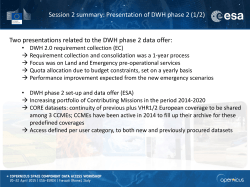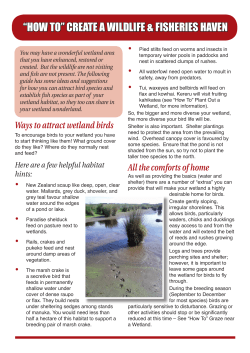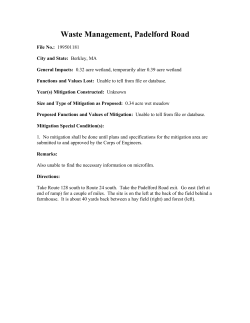
Technological Developments for Automated Production of
TECHNOLOGICAL DEVELOPMENTS
FOR THE PRODUCTION OF
HR WATER LAYERS
Dr Gediminas Vaitkus
GEOMATRIX uab
gedas.vaitkus@gmail.com
EXTRACTION OF WATER MASK
IMAGE 2006
REFLECTANCE
NDVI
WATER
PRODUCTION SPECIFICATIONS
Accuracy – up to 10 m
Automated cleaning
100% inspection for errors
QC – 20% of all objects
GRDA – Implementation of an Initial GMES Service for
Geospatial Data Access (DG-ENT: 2010-2012)
●
●
●
Open tender (DG-ENT) for GMES reference data production
Project objective – produce seamless high-resolution DEM and
hydrography reference datasets covering EEA38 territory (~6 mln km 2),
integrating the existing hydrography datasets and improving their
geometry and topology
Project consortium:
●
INDRA Espacio (ES) – project coordinator
●
INTERMAP (DE) – production of EU-DEM
●
AGI – production of hydrography reference layers
• G.Vaitkus (founder of GEOMATRIX uab) created automated
processing scripts, performed automated extrction of water bodies,
and computing of watersheds
●
Project supervised by a joint working group of EC, GMES Bureau, JRC, EEA
ir Eurostat representatives
CONCEPT : A REFERENCE DATABASE
AUTOMATIC PRODUCTION OF RASTER WATER MASK
FROM IMAGE 2006: ~2000 separate images processed
PREPARATION
OF IMAGES
PRODUCTION WORK-FLOW
Assembling
Mosaicking
Import
NDVI
Radiance
Filtering
reject
PROCESSING
OF RASTER
QUALITY
CONTROL
Boundary
PRODUCTION OF HYDRO- LAYERS:
AUTOMATIC
EXTRACTION
OF WATER
reject
100% of processed images inspected
Iterative processing to reach compliance to specs.
20% of all vector objects checked for each unit
Smoothing
accept
LINES
NODES
PROCESSING
OF ATTRIBUTES
QUALITY
CONTROL
DELIVERY OF
THE DATABASE
accept
MANUAL
MANUAL
DELINEATION
reject
- Internal QA/QC – ISO 9001:2000
Cleaning
Transfer to
DB / SDI
extracted from IMAGE-2006 MOSAIC
COV1 (reference) and COV2 (supplement)
delineated from IMAGE-2006 MOSAIC
and ancillary data (topo maps, etc.)
generated from network topology (lines)
QA/QC PROCEDURES:
Conv.
to vector
Attributes
QUALITY
CONTROL
- Lines
- Points
Size >1 ha
accept
PROCESSING
OF POLYGONS
- Polygons
- External QA/QC by project partners
100% “large” hydro-polygons checked during the data
integration process
TECHNOLOGY:
- Use of FOSS GIS tools
GRASS GIS, GDAL, etc. scripts for production of polygons
Quantum GIS for manual editing and QC
PostgreSQL/PostGIS for database storage
7
GRDA PRODUCTION SEQUENCE
8
THE EU-HYDRO PRODUCT
●
●
Maximum water level was taken as
reference for delineation of polygons
(excluding tidal zones);
River polygon objects were corrected and
merged to close narrow gaps due to
vegetation, etc.
Geometry corresponds to IMAGE-2006 reference, has 3 layers with topology
EU-HYDRO UPDATE 2015
GIO-LAND – GMES Initial Operations Land – Lot 6: Water &
Wetlands layers (EEA: 2013-2014)
●
●
●
●
Open tender for LOT-6 production
Project objective – production of seamless high-resolution permanent
water and wetland masks covering EEA39 territory (~6.3 mln km 2) by
processing all the available HR satellite imagery (IMAGE 2006/2009/2012)
Project consortium:
●
INDRA Espacio (ES) – project coordinator, production of grassland
●
DLR (DE), EUROSENSE (BE) – production of grassland
●
GEOMATRIX uab – production of water and wetlands layers
Production of water and wetlands layers was carried out by automated
parallel computing based on open-source technologies
CONCEPT : A STATISTICAL PRODUCT
2006.07.01
2006.09.12
2007.04.25
2007.05.21
SWAM – Sum of Water Masks
WAPI – Water Presence Index
TIME-SERIES ANALYSIS
spring (IRS-6: 2009/04/06)
Vegetation Index
(NDVI)
Water Index
(NDWI)
summer (IRS-6: 2008/08/14)
Vegetation Index
(NDVI)
Water Index
(NDWI)
PERMANENT & TEMPORARY OBJECTS
WATER
WETLANDS
Dark color – “permanent”
water
{WAPI => 0.5}
Dark color – “permanent”
wetland
{WEPI => 0.5} OR
{WAPI < 0.5 AND WEPI => 0.5}
Light color – “temporary”
water
{WAPI < 0.5}
Light color – “temporary”
wetland
{WEPI < 0.5} OR {WAPI < 0.5}
COMBINED LAYER
PRODUCTION
WORK-FLOW
IRS6/SP5 – High Resolution satellite images –
IRS6/SPOT4,5 (IMAGE2006/2009/2012);
AWIFS – Medium Resolution satellite images
(AWIFS time-series);
BPP – Biophysical parameters (Total Radiance,
NDVI, NDWI, WI);
SBPP – Summary layers for BPP (minimum,
maximum, range);
EU-DEM – The standard EU-DEM product (30 m
resolution, EPSG:3035);
SML – Slope Mask computed from EU-DEM;
SSL_09 – Soil sealing dataset (imperviousness 2009
product - 20 m resolution, EPSG:3035);
SSM – Soil Sealing Mask (>20 %) computed from
SSL_09;
WAM – binary raster mask indicating presence of
water In a separate image;
WEM – binary raster mask indicating presence of
wetlands (water + adjacent wetlands vegetation) in
a separate image;
IM – binary raster mask covering non-null values of
a separate image;
SWAM – sum of water mask values from all
processed images;
SWEM – sum of wetlands mask values from all
processed images;
SIM – sum of image masks of all processed images;
WAPI – Water Presence Index ( SWAM / SIM);
WEPI – Wetlands Presence Index (SWEM / SIM);
PWAL – Permanent Water Layer ( { WAPI ≥ THR} );
PWEL – Permanent Wetlands Layer ( { WEPI ≥ THR}
- PWAL );
THR – threshold value of WAPI and WEPI for
computing PWAL and PWEL.
PROBLEM – IMAGE AVAILABILITY
LT – SIM
LT – WAPI
BPP SEGMENTATION
In order to compensate for
insufficient availability and
quality of IRS-6 images in
moderate and northern
latitudes, a new method of
BPP segmentation was
developed and non-waterrelated wetland segments
were integrated into the
HRL Wetland layer. This will
be done in some of the
southern European
countries during the
enhancement phase.
HRL WATER & WETLAND LAYERS
VHR SPOT 5
2011/06/24
Turkey
HRL Wetland
HRL Water
RECENT DEVELOPMENTS
Consolidation of technological developments resulted in an integrated
EO imagery pre-processing and analysis technological process:
●
●
●
●
Highly-efficient, completely automated and production-ready
technological solution;
Based exceptionally on the Open-Source software and platforms;
Focused on multi-purpose GMES/Copernicus downstream production
operations;
Capable of handling both HR and VHR EO Data products.
Operational testing carried out in summer 2014 on pan-European
coverages of:
●
HR (5 m) RapidEye (ESA DWH_MG2_CORE_01 Coverage_2)
●
VHR (2.5 m) SPOT 5/6 (ESA DWH_MG2b_CORE_03 Coverage_2)
STEP 1 : PRE-PROCESSING
Automated image pre-processing:
Outputs – production-ready images
and mosaics
STEP 2 : ANALYSIS
Automated image analysis:
Inputs – pre-processed mosaics;
Parallel processing in tiles;
Integrated I/O products chain;
Manual process control & QC;
Automated all computing steps;
Flexibility on extensions from
“Core” output products to
“Downstream” processes.
CONCEPT : PRE-CLASSIFIED OBJECTS
●
●
●
●
●
Mosaicking of single-pass images into disconnected regions in order to
reduce the number of iterations and avoid discrepancies of statistics;
Computing of a broad range of biophysical parameters for the analysis of
land cover structure and assessment of environmental conditions;
Correction of the originally pan-sharpened VHR satellite images by
computing piece-wise smooth approximation of each spectral band;
Object-based classification of satellite images implemented as automated
parallel processing work-flow and tested on pan-European coverage of
HR RapidEye and VHR SPOT-5 imagery;
Zonal statistics (per “object”) computed from a series of biophysical
parameters, DTM and ancillary datasets are used for extraction of land
cover classes by conditional filtering.
BIO-PHYSICAL PARAMETERS
RGB543
NDVI
RDVI
NDWI
OBJECT-BASED CLASSIFICATION
Automated object-based
classification of combined layers
with BPP and ancillary datasets
produce standard “pre-classified”
VHR land cover products useful for
“core” LC analysis and mapping.
Examples: Biophysical LC of the
Northern Italy (RapidEye imagery).
A COMBINED WATER OBJECT
CORRECTION OF VHR IMAGERY
VHR SPOT 5 color-balanced RGB:123
composite image of Turkey taken on
2011/06/24 (DWH_MG2b_CORE_03):
due to pan-sharpening, the image contains a
significant amount of digital noise on
homogeneous surfaces (especially water)
After piece-wise smooth approximation
(segmentation) of the input raster map,
most of the digital noise is removed on
heterogeneous surfaces, yet the natural
discontinuities are preserved
PROCESSING OF CORRECTED DATA
NDVI computed from the approximated image Segmentation of the NDVI layer computed
from the approximated image of Turkey taken
of Turkey taken on 2011/06/24.
on 2011/06/24.
After piece-wise smooth approximation, the
NDVI layer does not contain any traces of the This pre-classified product can be used as
input for extraction of water objects.
digital noise, present in the original image.
HR / VHR COMPARISON
VHR SPOT 5 image of Turkey taken on 2011/06/24 (enhanced RDB 123 color
composite; source: DWH_MG2b_CORE_03). Yellow line – old GRDA coastline.
HRL WATER & WETLAND
GIO-Land products: HRL Permanent Water (blue) and HRL Wetland (green)
displayed on top of an enhanced VHR SPOT 5. Yellow line – old GRDA coastline.
VHR PRE-CLASSIFIED
VHR pre-classified BPP dataset produced from VHR SPOT 5 image of Turkey
(2011/06/24). Red line – old GRDA coastline.
OPERATIONAL TESTING
A part of FP7 LAMPRE project tasks on
technological developments:
●
●
7 processing workstations (i7, 32 Gb
RAM, 4 Tb RAID-0, Ubuntu 14.04 LTS);
2 production servers:
●
●
GRASS DB server (i7, 16 Gb RAM, 26
Tb RAID-5, Ubuntu 14.04 LTS);
File/FTP/GeoNode server (i5, 16 Gb
RAM, 16 Tb RAID-5);
~23,000 HR RapidEye images with 5 m
pixel resolution and 12-bit data depth
(IMAGE2012, Coverage-2) were used;
~5,000 VHR SPOT5/6 images with 2.5 m
pixel resolution (DWH_MG2b_CORE_03)
were used;
EU-DEM elevation dataset was used;
Parallel processing with GDAL & GRASS
software implemented and tested.
DATA HANDLING ISSUES
NFS service was used for
inter-connected BIG Data
storage;
On-the-fly transfer from
storage through processors
to the main GRASS DB;
Only final products are
stored in the system;
No data is kept on the
processing servers
(vulnerable 4x RAID-0
spinning disk arrays);
Archiving and removal of
GRASS DB mapsets also
allows easy transfer of large
databases.
Source: FP7 LAPMPRE D4.3
CONSOLIDATED USE-CASES
Use-Cases:
Outputs:
Acquisition of EO images
Original EO datasets
Pre-processing of EO images
(with manual ortho-rectification)
Production-ready GeoTIF images (packaged with
metadata and previews)
Mosaicking of EO images
Unique (spatio-temporal) mosaics:
- Satellite images (multi-spectral)
- Derivative products (single-band)
Computing bio-physical
parameters
Multiple biophysical products (multi-spectral data
transformed into standard parametric data layers)
Computing time-series statistics
Layers of statistical values (statistical values computed
from parametric data layers) – input for change detection
Image segmentation and
discontinuity detection
Piece-wise smooth approximation of each spectral band
– removal of pan-sharpening “noise”
Object-based classification
Segmentation layer (raster)
Zonal statistics for the objects
Aggregated statistics from ancillary datasets
Land-cover extraction
Conditional filtering into Land Cover classes
© Copyright 2025











